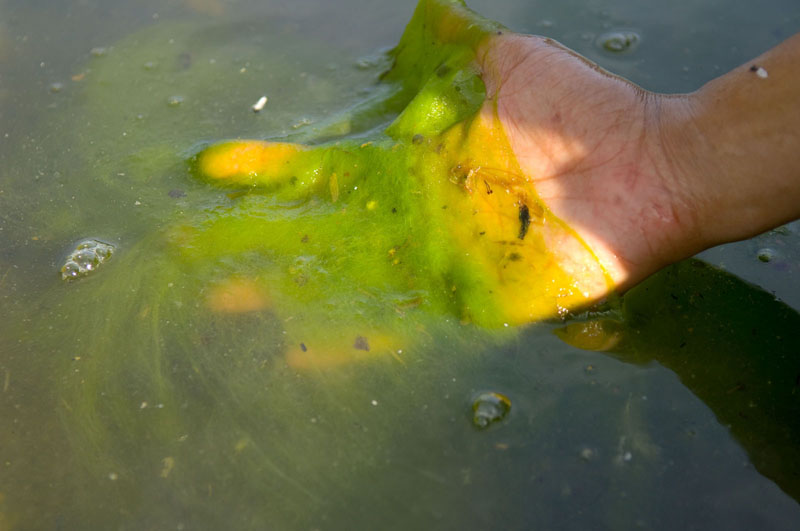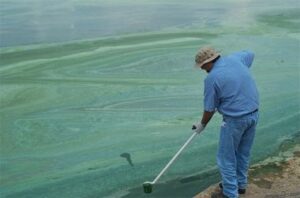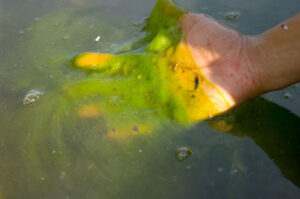What’s That Green Stuff? Common Misconceptions about Algae and Beyond

By Ava Schimnowski, Aquatic Plant Management Specialist Individual Placement /AmeriCorps member at Minnesota Department of Natural Resources Division of Fish and Wildlife
Many people mistake harmless water plants like duckweed for toxic algae or assume that all algae are the same. In reality, not everything green in the water is algae, and some ‘algae’ aren’t even algae at all. This post will break down common misconceptions and provide clarity on what’s floating in our lakes and ponds. Are these blooms harmful, and what causes them? Let’s explore the facts.
Algal blooms thrive on excess nutrients, particularly nitrogen and phosphorus, which often come from human activities. Runoff from agricultural fields, lawns, and streets carries fertilizers, animal waste, and organic debris like leaves into bodies of water. In Minnesota, seasonal changes such as the falling of leaves in autumn, combined with warm summer weather, can introduce a significant amount of nutrients into lakes and ponds. This nutrient influx fuels rapid algae growth. With Minnesota’s summers becoming increasingly warmer, we can see the direct effects of climate change on our waters.
Toxic Algae Blooms

It’s important to remember that not all algae blooms are toxic, and you can’t determine if a bloom is harmful just by looking at it. State agencies like the Minnesota Pollution Control Agency (MPCA) regularly test water samples for algal toxins. Local governments and health departments may also monitor water quality in recreational lakes.
Some algae contain toxins, which can cause illness in humans and animals. In Minnesota, the most common bloom-forming toxic algae are blue-green algae. Blue-green algae are not algae at all, but types of bacteria called cyanobacteria. This type of bacteria thrives in warm, nutrient-rich water. When conditions are right, the blue-green algae can grow quickly forming “blooms.” Certain varieties of blue-green algae can produce toxins that are linked to illness in humans and animals.
Blue-green algal blooms are often described as looking like pea soup or spilled green paint, and have a swampy odor when they break down. They prefer warm, calm, sunny weather and water temperatures higher than 75°F. Blooms usually occur during summer and early fall.

Filamentous algae
Sometimes confused with blue-green algae, filamentous algae are single cell organisms that grow in long strands, or filaments. These filaments can intertwine to form long mats which float to the surface of the water. It can also grow on submerged objects like aquatic plants or rocks. Though unsightly, green filamentous algae is harmless to human health.
An easy way to tell the difference between blue-green algae and filamentous algae is to use a stick to pick up some of the algae. If it drapes over the stick and you can see the strands, it is probably filamentous algae. If the stick passes through the water without picking anything up, it is likely blue-green algae, or cyanobacteria.

Duckweed
From a distance, duckweed is often mistaken for algae – it may form a thick, green blanket on the water surface. However, unlike filamentous algae, duckweed are not interconnected, and are actually tiny, free-floating plants with small roots that hang down into the water.
Duckweed commonly occupies smaller bodies of water, and rarely become overabundant on lakes and large ponds due to wind and waves.
They provide food for waterfowl and marsh birds, and support insects that fish eat. However, they can shade out other larger, submerged plants.
Fun fact: duckweed, specifically the genus Wolffia within the duckweed family, is considered the smallest flowering plant in the world.
Recognizing the differences between toxic blue-green algae and harmless algae and plants is key to keeping our waters safe. By managing nutrient runoff and understanding what’s in the water, we can reduce harmful algal blooms and protect both the environment and public health.
References:
Blue-green algae: www.pca.state.mn.us/air-water-land-climate/blue-green-algae-and-harmful-algal-blooms
www.pca.state.mn.us/business-with-us/harmful-algae-blooms-water-recreation-advisories
Filamentous algae: www.minneapolisparks.org/wp-content/uploads/2023/03/Filamentous-Algae-Fact-Sheet.pdf
MPCA: www.pca.state.mn.us/sites/default/files/wq-s1-90.pdf
Duckweed: www.dnr.state.mn.us/aquatic_plants/floatingleaf_plants/duckweeds.html